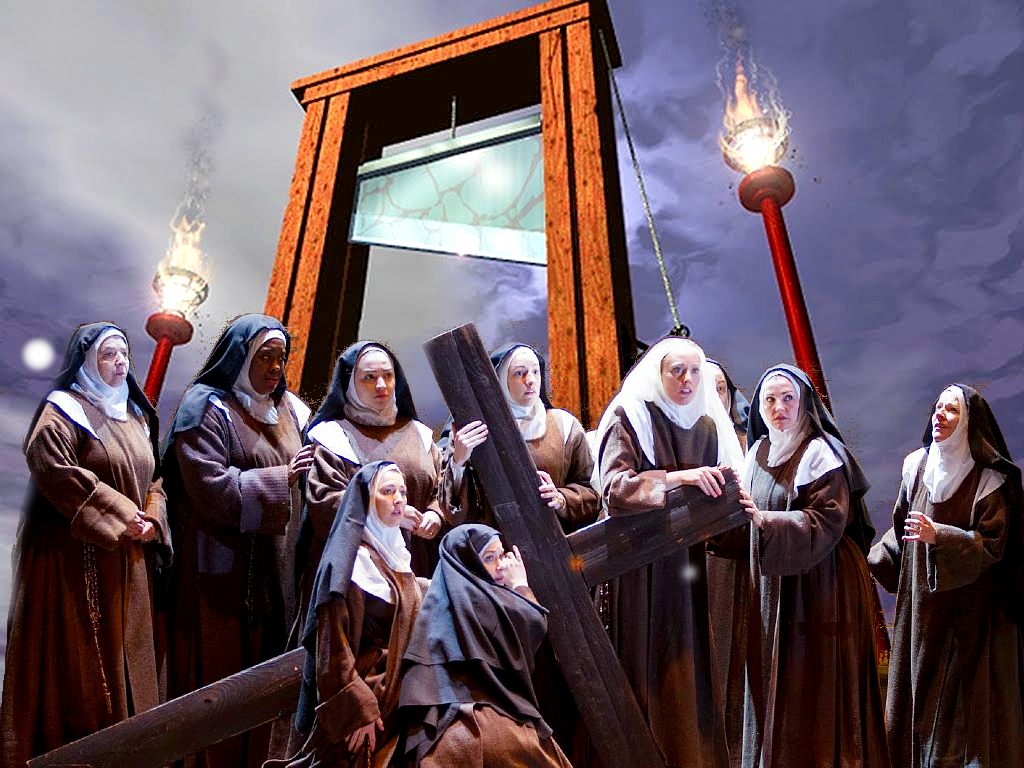By Patrick Giroux
 France’s most celebrated martyr, Joan of Arc, was captured at the gates of the city of Compiègne in northern France in 1431. The stark history of martyrdom would repeat itself more than 350 years later in that same town, except this time it was an entire convent of nuns who would offer the ultimate sacrifice of their lives for the Church and the world. This is the story of the Carmelite martyrs of Compiègne.
France’s most celebrated martyr, Joan of Arc, was captured at the gates of the city of Compiègne in northern France in 1431. The stark history of martyrdom would repeat itself more than 350 years later in that same town, except this time it was an entire convent of nuns who would offer the ultimate sacrifice of their lives for the Church and the world. This is the story of the Carmelite martyrs of Compiègne.
An early Church Father, Tertullian, is quoted as saying that “the blood of the martyrs is the seed of the Church”. A simpler way to put this is that “death begets growth”. To the world, this is paradox at its finest. When viewed through the lens of Christianity, however, the phrase holds a profound truth: it is not simply death, but death redeemed and offered for the sake of Christ, that begets growth:
Amen, amen, I say to you, unless a grain of wheat falls to the ground and dies, it remains just a grain of wheat; but if it dies, it produces much fruit. (John 12:24)
A Diabolical Revolution
The incredible story of the Carmelite martyrs takes place in 1794 almost as the crowning act of cruelty of one of history’s bloodiest revolutions. Beginning in 1789, the French Revolution marked a time of extreme turmoil in France. It was preceded by a period of general moral decay of the citizenry, occasioned by extreme persecution of the Church in the name of progressive ideals and followed by carnage in every facet of French society.
The violence of the Revolution reached its peak in what was known as the Reign of Terror (1793-94) during which more than 300,000 people were arrested and more than 17,000 executed as “enemies of the state”. Many of these were Catholic clergymen and religious. I am sure that Joan of Arc and many of the other great French saints were rolling over in their graves during this time.
Another important thing to remember is that part of the French Revolution entailed the disbanding of monasteries and convents by the state because they were considered as offering no “benefit” to society. Clearly, the secular French state did not understand the power of prayer.
A New Law
The Civil Constitution of the Clergy, a law passed by the radicalized civil government, demanded that clergymen take an oath of loyalty to the National Assembly. Any who took the oath effectively ceded all control of the Church in France to the power of the atheistic government.
Many priests (roughly half), as well as seven bishops took the Oath, but many other clergy and religious refused. This was a weighty decision that cost many of them their very lives, yet, these courageous men and women gained eternal crowns through their martyrdom:
They conquered him by the blood of the Lamb and by the word of their testimony; love for life did not deter them from death. (Revelation 12:11)
A group of courageous women such as this resided in a Carmelite convent in Compiègne, just north of Paris. They had been thrown out of their monastery in September of 1792 but courageously continued their lives of prayer in solitude despite what was at stake.
Sometime later, their “counterrevolutionary behavior” was discovered, and a group of sixteen Carmelite nuns and their associates were arrested in June of 1794. On July 17th – the day after the feast of Our Lady of Mount Carmel – they were sentenced to death by guillotine for treason against the state.
It is here that this tragic story goes from one of tribulation to that of triumph.
Triumph Over Death
A wise friend of mine once told me that death is foreign and uncomfortable to us because it was never meant to be. In God’s original plan, we were made to be in perfect union with Him forever. Fear of death, however, makes the Gospel message that much more profound. Christ came that we might have life! His Resurrection gives us confidence that by dying in Christ, we might also rise with Him.
The nuns and their companions were a living testimony to this truth. On that July day in 1794, as they were being taken to the place of their execution, they sang hymns and prayed with one another. They were dressed in their full Carmelite habits as they went to the guillotine.
Arriving at the place of execution, the Mother Superior intoned the Te Deum – a hymn of praise and thanksgiving to God – and all the sisters sang it with her. They all renewed their religious vows, as they stood at the brink of death, and when it came time for the blood of these martyrs to be shed, the first sister to ascend the steps of the guillotine invoked one of the Psalms of David:
Praise the Lord, all you nations! Extol him, all you peoples! His mercy for us is strong; the faithfulness of the Lord is forever. Hallelujah! (Psalm 117:1-2)
These brides of Christ handled their deaths not only with extreme dignity, but also with joyful confidence in God.
The Final Act: Obedience
We can only imagine the shock of the executioners at the astonishing scene they were witnessing: as each sister mounted the platform for execution, they asked their Mother Superior, one by one, “Permission to die, Mother?”
Thus, the last act of these martyrs was one of religious obedience rather than civil subservience. The unruly crowd, which usually made all sorts of commotion during executions, remained silent. The corpses of the nuns were then thrown into a mass grave with the rest of the victims of the Revolution.
Christian martyrdom has many positive spiritual effects on the Church and the world, which sometimes even spill over into actual material effects. For example, many believe that it was the sacrifice of these holy women that brought an end to the Reign of Terror itself, which seemed to spend itself and come to its bitter end just ten days after the sisters’ martyrdom.
And although France by no means saw a total restoration of religious faith and culture immediately after the Revolution, other new “seeds” of the Church were planted and did spring up after the death of these women. One of the greatest fruits of their martyrdom was the eventual priestly ministry of the great Saint John Vianney, patron saint of priests, who was just eight years old when the nuns made their ultimate sacrifice.
The principle of martyrdom remains true in all ages from Tertullian to the present: Death begets growth.
The Sixteen Carmelite Martyrs
Mother Teresa of St. Augustine, prioress
Mother St. Louis, sub-prioress
Mother Henriette of Jesus, ex-prioress
Sister Mary of Jesus Crucified
Sister Charlotte of the Resurrection
Sister Euphrasia of the Immaculate Conception
Sister Teresa of the Sacred Heart of Mary
Sister Julie Louise of Jesus, widow
Sister Teresa of St. Ignatius
Sister Mary-Henrietta of Providence
Sister Constance
Sister St. Martha
Sister Mary of the Holy Spirit
Sister St. Francis Xavier
Catherine Soiron
Thérèse Soiron

Soul Work
Saint John Paul II once told a priest visiting him, “Don’t waste your suffering.” This powerful story of the Carmelite martyrs illustrates this principle. These women not only endured their crosses for the sake of Christ, but they embraced them and offered them to God in union with the Cross. That is the attitude of saints.
Next time you come across a little suffering – perhaps a frustrating situation at work, or a family member who does something that bothers you – offer it to the Lord and embrace the suffering with love. Thus, it can become redemptive, and you will not let it “go to waste”.
Then, take it one step further like the Carmelites of Compiègne who praised the Lord and even sang hymns as they faced their final trial. When you experience any suffering, large or small, try smiling, thanking the Lord, or saying a brief prayer of thanksgiving:
For whom the Lord loves, he disciplines; he scourges every son he acknowledges. (Hebrews 12:6)
Lastly, the story of the Compiègne martyrs shows that community can be a powerful force. Think of your three closest friends and ask yourself the questions: Are we leading each other closer to Christ? Do we push each other to become the best versions of ourselves, or do we fall into sinful behavior together?
If the answers are in the positive, keep investing in those relationships. If not, try finding good, faithful people with whom to share the journey to heaven.
———-
Sources: Carmelite Nuns of Great Britain site, Simply Catholic, Sensus Fidelium




Truly moving and inspiring. As one who has experienced a taste of persecution, this beautiful, powerful story of the sixteen Carmelite Martyrs inspires me to readiness. “Permission to die, mother?”
Thanks Michael! We may need the martyrs’ intercession soon. All the best, PD